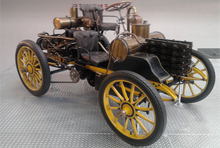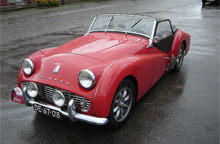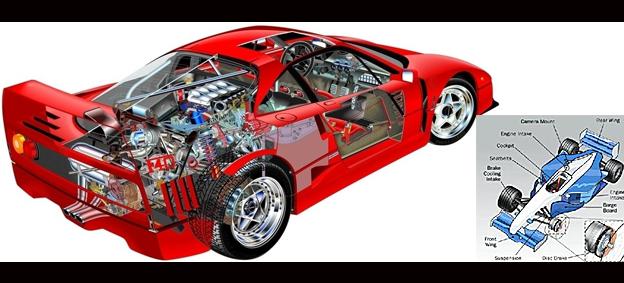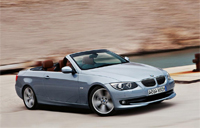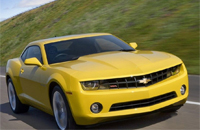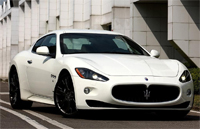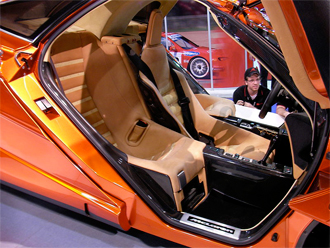| A sports car (sports car or sport car) is a small, usually two seat, two door automobile designed for spirited performance and nimble handling. Sports cars may be spartan or luxurious but high maneuverability and minimum weight are requisite. |
Histroy of the sport car
| | | |
| The sports car traces its roots to early 20th century touring cars and roadsters. These raced in early rallys, such as the Herkomer Cup, Prinz Heinrich Fahrt, and Monte Carlo. Though the term would not be coined until after World War One, the first sports cars are considered to be the 3 litre 1910 Prince Henry (Prinz Heinrich) Vauxhall 20 hp (tax rating) and the 27/80PS Austro-Daimler designed by Ferdinand Porsche. These would shortly be joined by the French DFP (which became sporters after tuning by H.M. and W. O. Bentley) and the Rolls-Royce Silver Ghost. In the U.S., where the type was variously called roadster, speedster, runabout, or raceabout, there was Apperson, Kissel, Marion, Midland, National, Overland, Stoddard-Dayton, and Thomas among small models, while Chadwick, Mercer, Stutz, and Simplex were among large models. In 1921, Ballot premiered its 2LS, with a remarkable 75 hp (56 kW) DOHC two liter, designed by Ernest Henry (formerly of Peugeot's Grand Prix program), capable of 150 km/h (90 mph); at most, one hundred were built in four years. This was followed by the SOHC 2LT and 2LTS. The same year, Benz built a supercharged 28/95PS four for the Coppa Florio; Max Sailer won. View more… | ||
Layout of the sport car
| |
| The drive train and engine layout significantly influences the handling characteristics of an automobile, and is crucially important in the design of a sports car. The front-engine, rear-wheel drive layout (FR) is common to sports cars of any era and has survived longer in sports cars than in mainstream automobiles. Examples include the Caterham 7, Mazda MX-5, and the Chevrolet Corvette. More specifically, many such sports cars have a FMR layout, with the centre of mass of the engine between the front axle and the firewall. In search of improved handling and weight distribution, other layouts are sometimes used. The RMR layout is commonly found only in sports cars—the motor is centre-mounted in the chassis (closer to and behind the driver), and powers only the rear wheels. Some high-performance sports car manufacturers, such as Ferrari and Lamborghini prefer this layout. View more… |
Different types of the sport car
| | A coupé or coupe (from the French past participle coupé, of the infinitive couper, to cut) is a closed car body style (permanently attached fixed roof), the precise definition of which varies from manufacturer to manufacturer, and over time. While the majority of coupes are two-door vehicles, several four-door vehicles (including the Mercedes-Benz CLS and Rover P5 Coupé) have been referred to as "coupes" by their manufacturers. View more… |
| | Muscle car is a term used to refer to a variety of high-performance automobiles. The Merriam-Webster dictionary defines muscle cars as "any of a group of American-made 2-door sports coupes with powerful engines designed for high-performance driving." A large V8 engine is fitted in a 2-door, rear wheel drive, family-style mid-size or full-size car designed for four or more passengers. View more… |
| | Supercar is a term used most often to describe an expensive high end car. It has been defined specifically as "a very expensive, fast or powerful car". Stated in more general terms: "it must be very fast, with sporting handling to match", "it should be sleek and eye-catching" and its price should be "one in a rarefied atmosphere of its own". View more… |
| | A grand tourer (GT) is a high-performance luxury automobile designed for long-distance driving. The most common format is a two-door coupé with either a two-seat or a 2+2 arrangement. The term derives from the Italian phrase gran turismo, homage to the tradition of the grand tour, used to represent automobiles regarded as grand tourers, able to make long-distance, high-speed journeys in both comfort and style. The English translation is grand touring. View more… |
Seating of the sport car
| Some sports cars have small back seats that are really only suitable for luggage or small children. Such a configuration is often referred to as a 2+2 (two full seats + two "occasional" seats). The more typical seating arrangement is two-seats. Over the years, some manufacturers of sports cars have sought to increase the practicality of their vehicles by increasing the seating room. One method is to place the driver's seat in the center of the car, which allows two full-sized passenger seats on each side and slightly behind the driver. The arrangement was originally considered for the Lamborghini Miura. | |
| Another British manufacturer, TVR, took a different approach in their Cerbera model. The interior was designed in such a way that the dashboard on the passenger side swept toward the front of the car, which allowed the passenger to sit farther forward than the driver. This gave the rear seat passenger extra room and made the arrangement suitable for three adult passengers and one child seated behind the driver. The arrangement has been referred to by the company as a 3+1.[citation needed] Some Matra sports cars even had three seats squeezed next to each other. | |
Terminology
| A car may be a sporting automobile without being a sports car. Performance modifications of regular, production cars, such as sport compacts, sports sedans, muscle cars, hot hatches and the like, generally are not considered sports cars, yet share traits common to sports cars. They are sometimes called "sports cars" for marketing purposes for increased advertising and promotional purposes. Performance cars of various configurations are grouped as Sports and Grand tourer cars or, occasionally, as performance cars. |

